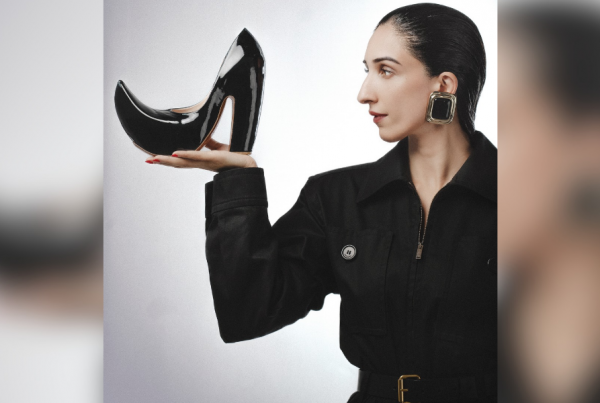(Instep, June 8, 2010)
We’re a queer lot of people. Confused. In fact we’re almost messed up as a nation. And that’s reflected most ostensibly in the way we dress.

Ronak Lakhani and Faiza Samee enjoy their shirts free and flowing while Frieha Altaf, in a shape-up mission decides to embrace glamour with this Shehla Chatoor black satin number, not for the faint hearted.
Consider this: one little step outside the house will determine that it’s hot; summers are weighing heavily upon us. The mercury is rising to unbearable levels (despite the rain) and at least in Karachi, the humidity is bad enough to send the asthmatic into intensive care. Take a couple more steps out onto the streets where the common man walks (or rather wades these days) and you’ll be slapped by the fact that we’re a nation crumbling under economic pressure. As if you needed to be told. Here we are, weighing the prospects of the budget being more destructive than the cyclone! The air reeks of nothing more than poverty. Inflation is back breaking and the price hikes make the most basic necessities of life as precious as any luxury. Now is the best time to cut back, you’d think. Well, that’s where our characteristic queerness kicks in.
Any sane person would take a look at our statistics and conclude that we’re a population trying to survive various types of pressures. But the stark reality, when it comes to clothes, couldn’t be further from the truth. Here we are, surviving inflation by adding volume to clothes. Our tops have gone from kurtis to kurtas with up to 100 panels. That is an insane amount of fabric being used for one outfit. Even the simplest of current styles require double the fabric to tailor for they must have flair. If not flair then pleats. If not pleats then ruffles. And if not even ruffles then at least an A-line silhouette with a hemline dropping to 50 inches. At least 50 inches, we scream at our tailors, God forbid someone should think we’re sartorially challenged. In fact the volume in our clothes almost belongs to the Renaissance Period where fashion was ‘used to establish social status and reinforce the hierarchy of upper class royalty and nobles over lower class commoners’. (Renaissanceclothing.blogspot)
Fashion was supposed to be a socio-economic measure of culture. The corset and can-can reflected a male dominated society;  Chanel’s little black dress called for liberation from that domination. The structured Dior suit called for women power that came with a symbolic broadening of the shoulders and the most recent trends in futuristic fashion, defined strongly by designers like Manish Arora and Christopher Kane, nudged the need to understand what the future holds for us. Wars dictated clothes into military camouflage and post war eras saw vivid colours make a comeback. Fashion has always had a purpose reflected by the time it has originated in.

Nabila, one of the industry’s most tasteful women, will never be caught dead in anything unflattering. And summers are surely for showing off a newly acquired, shapely silhouette.
But what can we deduce from Pakistani fashion today? One look at those regal trailing hemlines would convince anyone that we were a nation rolling in prosperity. It’s not just high-end designer labels we’re talking about here. This applies to fashion as basic as lawn, which from being a simple piece of fabric cut out of a scroll, has gone to being an elaborate goody bag full of trinkets and add-ons. They come at a higher price. A price we ideally should be resisting having to pay.
But no. We are jumping for joy and rolling in the fact that our clothes are luxuriously voluminous. And here cuts in the double edge sword. We are adding inches simply because our clothes are no longer binding us to any contract of body measurement. A couple of mangoes merely skim the surface because our clothes automatically camouflage the extra pile up of inches. This cannot be good in any possible way. It’s time to call for change.
It’s time to call for structure. Structure in our lives and subsequently in our wardrobes. Ideally in our bank balances too. The long and flowing albeit elegant yet drastically misleading silhouette has got to go and we as the women must start this movement against it. No one is suggesting we pull out our Patiala shalwars (for that would only mean shifting volume from top to bottom and no one wants big bottoms) but we must at least tightening our belts and pull up our proverbial socks.
World over, summer is the season women shape up for, because it calls for body-baring of sorts. It calls for swimsuits and sleeveless shirts, for sun blocks and bronzers. We in Pakistan, on the other hand, are too busy covering up in our ‘flowy shirts’ (God, how I hate that term now) to tackle the intolerable heat. True they tend not to cling and allow the body to ventilate which is a pro, but the cons take over thereon. Designers claim that it has taken the flared silhouette over a year to reach Lahore from Karachi; women have invested a lot in this style and it will be kept alive till next year at least.
Agreed, but for those with the backbone for change, I would suggest a gradual comeback to socio-economic and vital statistical sanity. Take out at least one day of the week when you wear something fitted and structured. Once you’ve survived the shock of bulging in everything you own, you’ll realize this is a much needed, almost desperate measure. Good luck on the trip back to getting in shape, personally and fashionably!













